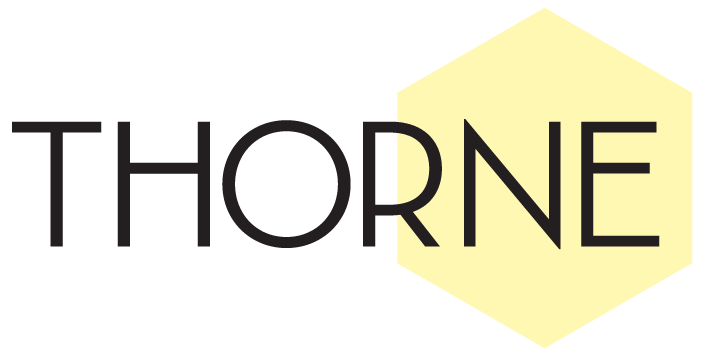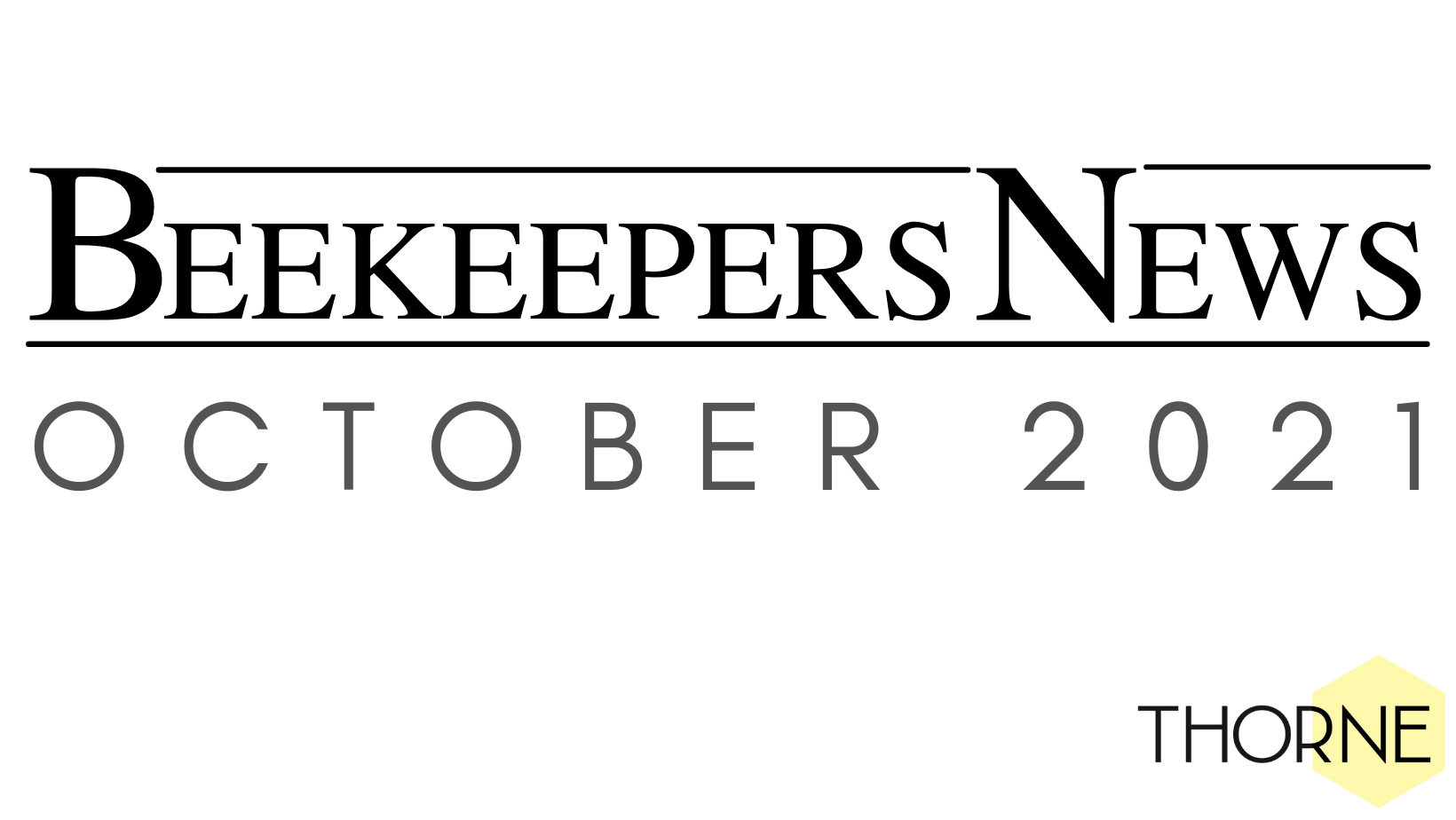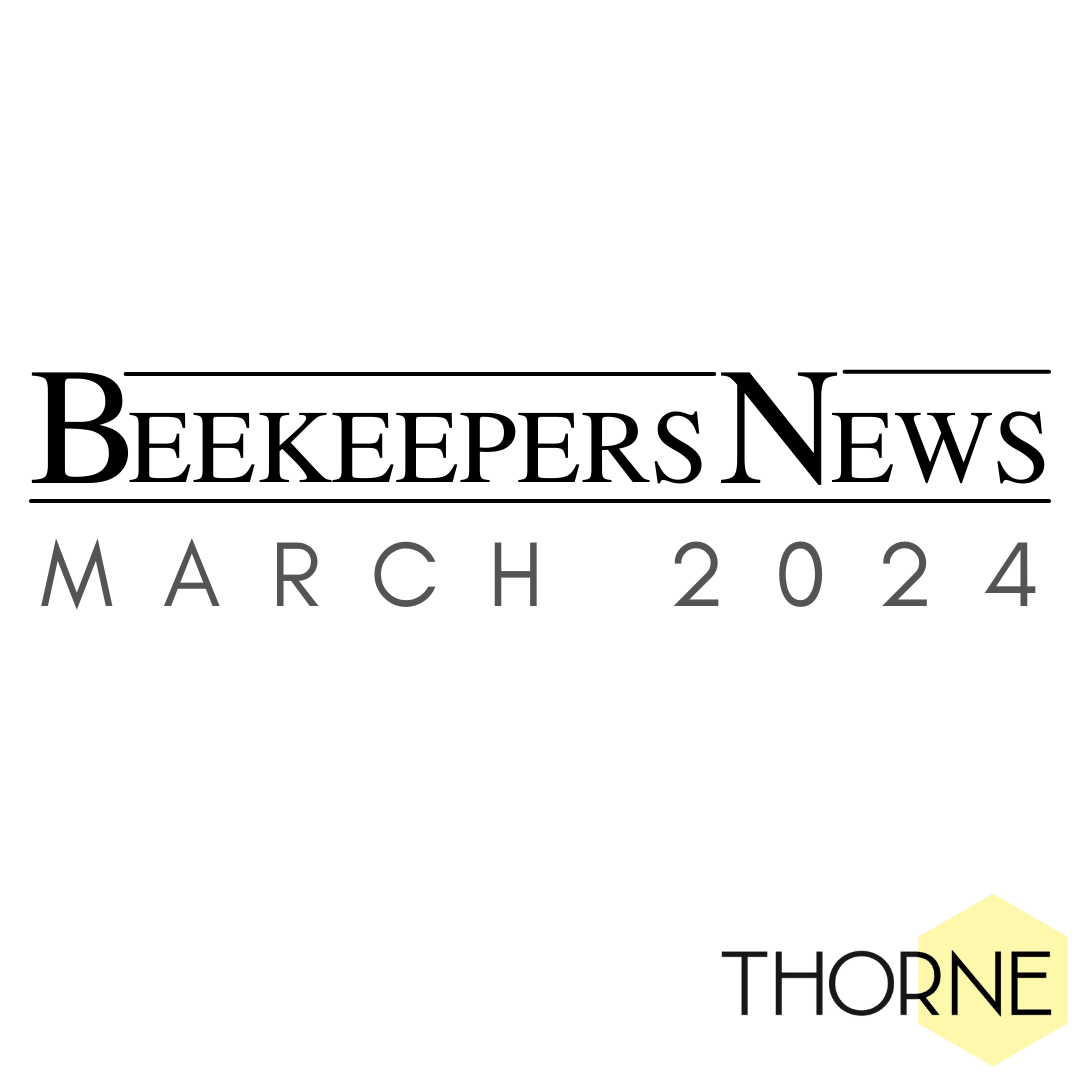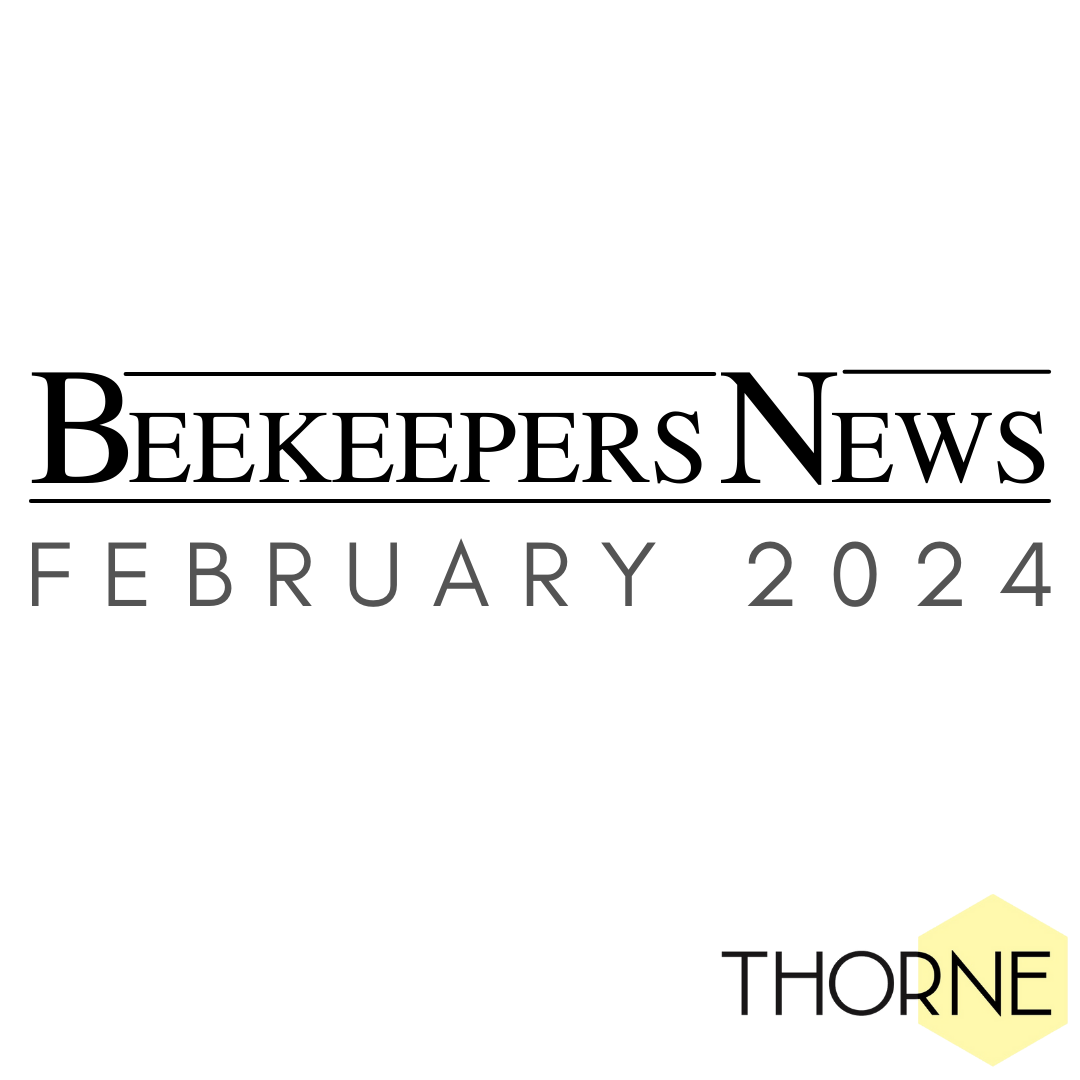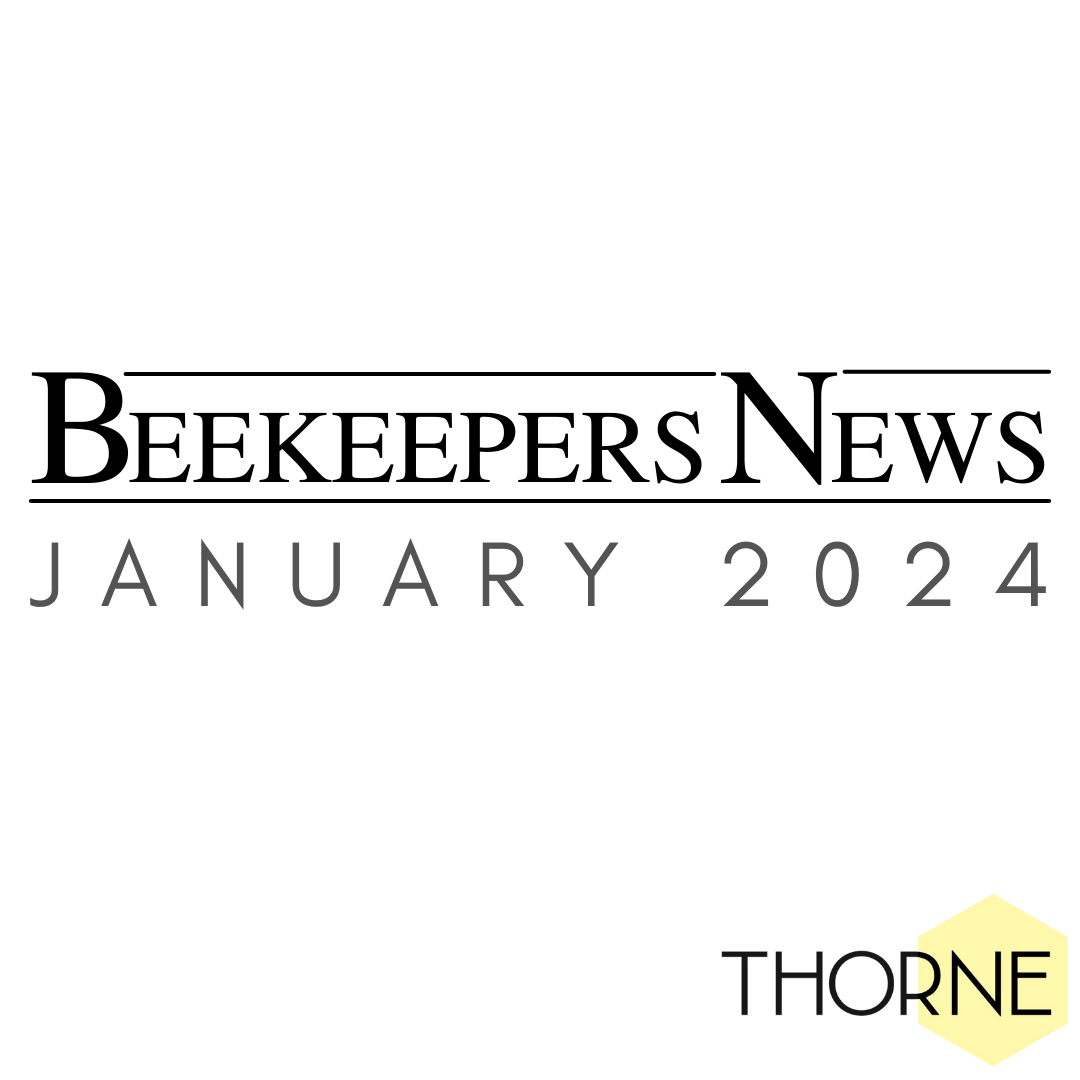Our Annual Sale Days have been a great success so far! The remaining events are our Sale (and Open!!) Day at our Headquarters here in Rand, Lincolnshire on Saturday 9th October, and the National Honey Show from Thursday 21st to Saturday 23rd October. Regarding the National Honey Show, if you are unable to attend and would like Thorne to take along any exhibits you wish to include in the Show, please make sure you have dropped these off at any of our English branches by the Wednesday 13th October.
The whole Thorne team at Rand are looking forward to welcoming you to our 2021 Sale and Open day on Saturday 9th October. As in previous years we will have a lot going on during the day. First up are our popular third quality hive parts, on sale this year from 8am. Primarily National brood bodies and supers, but we will have a few 14”x12”, Langstroth and Commercial boxes available as well. The standard National equipment will be packed in multiples of five and do not come with nails. Third quality hive parts will need some remedial work to make them fit for purpose. The table below shows the pricing structure and the numbers allowed per person.
|
Hive Part |
Price |
Packed in |
Limited to |
|
National Super |
£25 per pack |
5s |
8 packs per person |
|
National Brood Body |
£35 per pack |
5s |
4 packs per person |
|
National 14”x12” Brood |
£15 each |
Singles |
3 per person |
|
Other supers |
£5 each |
Singles |
No limit |
|
Other brood bodies |
£7 each |
Singles |
No limit |
You can also collect orders from 8am, follow the signs to the collection point.
Our main bargain shed will open at 9am. Here you will find all our usual sale items, second quality frames, British cedar hive parts, clothing, tools etc. We also have many shop soiled, returns and end of line items to be picked up at very low prices. There is still time to order for collection, follow the link below.
Don’t forget to join one of our factory tours. We have had a few changes in the workshop since the last open day and our new side bar machine is certainly worth a look. We will also have staff in the wax plant, engineers, sewing room, quality control and the assembly department. Please feel free to go in and have a chat.
We are thrilled to say that Darren from Protek paint will be here to talk to you about their range of bee friendly paints. We will also be offering 10% off the entire range of paint in store. Darren will be in our main shop so please do go and say hello.
The main shop and Buzz Stop café will be open from 8am until 3pm. Our full range of equipment will be available to buy and the restaurant will be offering their usual yummy sale day menu, including breakfast baps, baked potatoes, filled rolls, soup and snacks. Free tea and coffee are available throughout the day.
Our staff will be on hand in the shop to convert your beeswax into freshly milled sheets of foundation and there will be plenty of people to answer any questions you may have, especially if you are a beginner.
We have changed a few things this year to make things COVID secure. There will be plenty of ventilation and hand sanitising stations throughout the site and we will have gazebos up outside with tables and chairs so you can enjoy your breakfast or lunch. If you do have any questions about the day please email rebecca@thorne.co.uk.
This Month
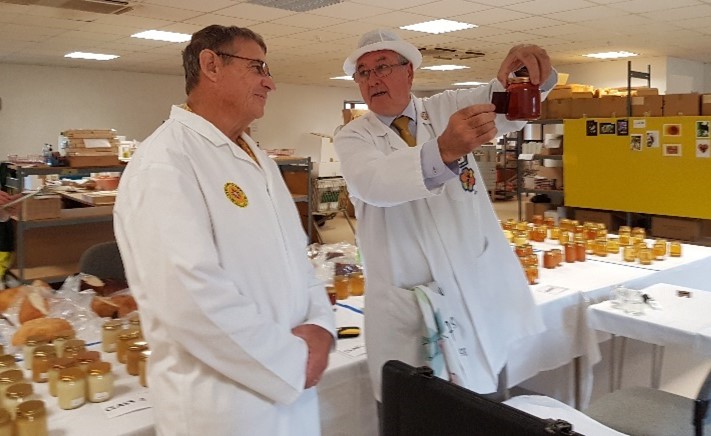 On the 4th September, we hosted the LBKA County Honey Show, due to the Lincolnshire Show not going ahead this year. The show was a huge success, with the highest number of entries for some years. The honey judges were Tony Jefferson from Whitby and Dave Shannon from Doncaster, and the confectionary judges were Sheila Cartwright from Wragby and Beryl Baker from Louth. The judges were very pleased with the quality of entries this year. Not only being able to present a Best in show BBKA Blue Ribbon but also a BBKA Reserve Best in show. A presentation of the trophies will take place at our HQ Open Day on the 9th October.
On the 4th September, we hosted the LBKA County Honey Show, due to the Lincolnshire Show not going ahead this year. The show was a huge success, with the highest number of entries for some years. The honey judges were Tony Jefferson from Whitby and Dave Shannon from Doncaster, and the confectionary judges were Sheila Cartwright from Wragby and Beryl Baker from Louth. The judges were very pleased with the quality of entries this year. Not only being able to present a Best in show BBKA Blue Ribbon but also a BBKA Reserve Best in show. A presentation of the trophies will take place at our HQ Open Day on the 9th October.
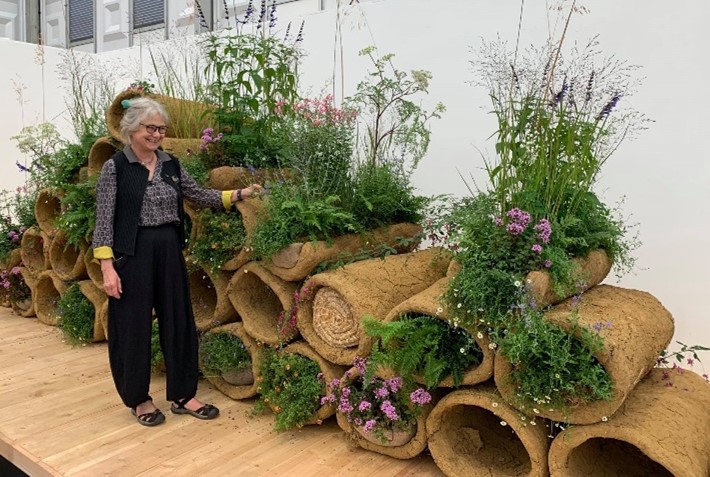
We were privileged to lend a hand to Bees for Development at the Chelsea Flower Show this September. The installation included sculptures made by Finbar Ward from hand dug clay, inspired by ancient beehives, decorated by Tilly Dallas with all kinds of bee-friendly plants, all sat on a floor of British Northumberland cedar made by Thorne! Here is Nicola Bradbear, director of Bees for Development, with the bronze medal winning display.
Special Offer
Apidry & Microsoja
We currently have 25% off both Api-dry (exp. 09/21) and Microsoja (exp. 10/21) at the moment. These powder supplements can be added to high-quality sugar syrup to use as a patty to provide the colony with added protein. This might be necessary during food shortages, in preparation for winter, going into spring and during queen breeding.
Both supplements are GMO-free and include all 10 amino acids essential to bees. Despite the similarities, the supplements contain different quantities of protein and vitamins, so it is therefore advised to use both Api-dry and Microsoja in the same patty to get the full coverage of amino acids.
[SHOP API-DRY HERE] [SHOP MICROSOJA HERE]
Equipment Focus
Feeding Boards
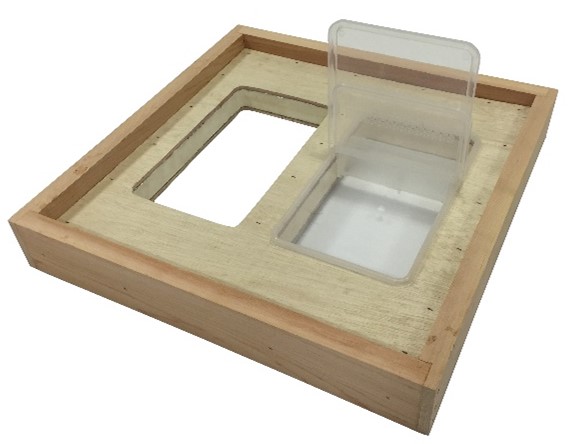 The cold is slowly starting to set in, and it is getting to that time of year when the bees are going to need a little help with food. Here is a little information about two of our feeders, that will make autumn and over winter feeding much easier. We will also have 10% off these feeders for the month of October.
The cold is slowly starting to set in, and it is getting to that time of year when the bees are going to need a little help with food. Here is a little information about two of our feeders, that will make autumn and over winter feeding much easier. We will also have 10% off these feeders for the month of October.
Firstly, we have the Robson Feeder Board. This feeder is based on an idea given to us by Willie Robson of Chain Bridge Honey Farm. The feeder has two, clear plastic, 1 litre compartments with hinged lids. Both can be used for syrup or fondant, pollen feeding or a combination. Bees access from directly underneath and the feed is kept warm, fresh, and moist by the heat generated from the colony. The feeders are encased in insulation foam and covered above by a snug fit chip foam insulated quilt. This feeder will only fit National or Commercial Hives.
[SHOP HERE] £40 £36
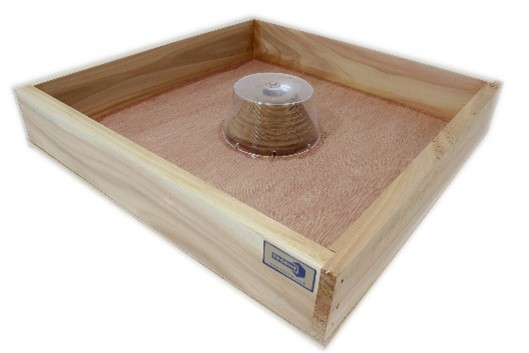 Next, we have the Budget Wooden Feeder. This feeder will fit National or Commercial hives and is supplied assembled. This timber feeder is supplied untreated and will require sealing with glue or wax, then painting with undercoat and gloss paint, prior to use. It holds 2 gallons of sugar syrup and has a central feed hole with clear plastic cover. The bees go up through the central hole, and over the top of the pyramid shaped wooden block. The block is rough sawn so the bees can grip onto this and will not slip into the syrup.
Next, we have the Budget Wooden Feeder. This feeder will fit National or Commercial hives and is supplied assembled. This timber feeder is supplied untreated and will require sealing with glue or wax, then painting with undercoat and gloss paint, prior to use. It holds 2 gallons of sugar syrup and has a central feed hole with clear plastic cover. The bees go up through the central hole, and over the top of the pyramid shaped wooden block. The block is rough sawn so the bees can grip onto this and will not slip into the syrup.
[SHOP HERE] £22 £19.80
Ask the Expert
Trading in wax
At this time of year, you may be starting to slow down and have time to refine your beeswax. We will be offering wax conversions at both our Sale and Open Day at Headquarters, and at the National Honey Show. Here is a rundown of how to trade in your wax. If you melt it down into blocks, we provide three options for you:
1. Trade it in on a ‘straight swap’ for foundation – no money involved
2. Trade it in on a conversion for foundation – you pay for wiring
3. Sell it to us outright or against goods
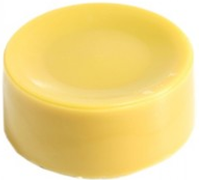
Clean block of beeswax
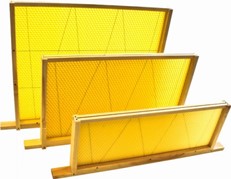
Diagonally wired foundation (frame not included in wax trade)
1. Straight Swap 
This is a straight exchange of crude wax into refined foundation. You provide the wax and we swap it for our premier foundation, wired or unwired. No cash changes hands but you get less wax per lb than on conversion.
The table below outlines how many sheets you get per lb of wax. Be sure to look in the right column for the amount of wax you bring in – under 50lbs or over 50lbs. Then decide which size foundation you would like and whether you want wired, unwired or thin for cut comb.
|
Foundation |
Under 50lbs |
Over 50lbs |
||||
|
Wired |
Unwired |
Thin super |
Wired |
Unwired |
Thin super |
|
|
BS Deep |
33/4 |
43/4 |
71/4 |
4 ¼ |
5 ¼ |
8 |
|
BS Shallow |
61/4 |
81/2 |
113/4 |
63/4 |
9 ¼ |
13 |
|
Commercial Deep (16"x10") |
3 |
31/2 |
|
3 ¼ |
4 |
|
|
Commercial Shallow (16"x6") |
43/4 |
53/4 |
83/4 |
5 |
6 ½ |
10 |
|
Dadant Deep |
21/4 |
3 |
|
21/2 |
3 ¼ |
|
|
Dadant Shallow |
43/4 |
53/4 |
81/2 |
5 |
6 ½ |
9 ¼ |
|
Langstroth Deep |
31/2 |
41/4 |
|
33/4 |
41/2 |
|
|
Langstroth Shallow |
51/4 |
7 |
91/4 |
6 |
8 |
10 ½ |
|
14"x12" |
21/4 |
3 |
|
21/2 |
3 ¼ |
|
|
Rose OSB |
3 ¾ |
4 ¾ |
|
4 ¼ |
5 ¼ |
|
|
Section squares |
|
|
43 ¾ |
|
|
49 ½ |
|
3 section length |
|
|
15 ¾ |
|
|
163/4 |
|
4 section length |
|
|
11 ½ |
|
|
13 |
This is a straight exchange of crude wax into refined foundation. You provide the wax and we swap it for our premier foundation, wired or unwired. No cash changes hands but you get less wax per lb than on conversion.
For example, if you bring in 30lbs of wax and would like all of it exchanged for Langstroth deep wired foundation, the calculation would be 30lbs x 3.5 = 105 sheets.
If you brought in 55lbs of wax and wanted 40lbs in Commercial deep wired and the rest in Commercial shallow unwired the calculation would be:
40lbs x 3.25 = 130 sheets Commercial deep wired
15lbs x 6.5 = 97.5 sheets Commercial shallow unwired (rounded up to 98).
2. Conversion
Again, this is an exchange of crude wax into refined foundation. You provide the wax, and we exchange it for premier foundation. You pay a conversion rate, but you get more wax per lb than on a straight swap. Wiring can then be done if needed at a set rate per 10 sheets of foundation. Below is the chart that shows how to work out the conversion charges:
First of all, depending on how much total crude wax you bring in, work out the conversion charge.
Wiring charge is worked out per 10 sheets of foundation – make sure to get the right size of foundation for the correct wiring charge.
This is the number of sheets you will get per 1lb of wax you bring in. So, you can either work out from the number of sheets you want how much wax you need to bring in or the other way round – how many sheets you will get for the wax you bring in.
|
|||||||||||||||||||||||||||||||||||||||||||||||||||||||||||||||||||||||||||||||
For example, if you had 50lbs of wax to bring in and you wanted it all in BS deep wired foundation, this is the calculation you would do:
50lbs x £1.63 = £81.50 (conversion charge)
50lbs x 8 = 400 (sheets)
40 x £1.25 = £50 (wiring charge)
So, you would pay a total of £131.50 in exchange for 400 sheets (40 packs) of ready to go, refined, wired BS Deep foundation. If you were to buy the same amount outright, it would cost you £540.
3. Sell it to us outright or against goods
Clean crude wax that has been melted down into blocks can also be sold outright or weighed in against goods:
|
Against purchase of goods, per kg |
£3.50 |
|
Outright purchase of wax, per kg |
£2.25 |
Blog
September
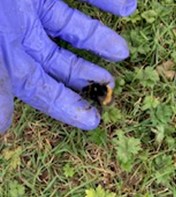 This month has been mostly consolidating what we have done over the season and setting the bees down for winter.
This month has been mostly consolidating what we have done over the season and setting the bees down for winter.
They were fed syrup earlier in the month when it was still nice and warm and we could tell that it was not only the honeybees who were hungry, but also other species such as this bumblebee! It actually flew straight into the feeder as we were pouring the syrup in so we quickly scooped it out and let it recover on the grass with a bit of syrup.
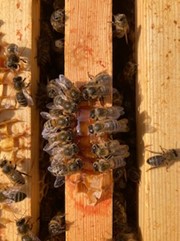 The bees have been busy collecting every little bit of nectar, honey or syrup possible, as you can see here where two brood boxes were merged into one for winter and the separation caused some nectar to be revealed:
The bees have been busy collecting every little bit of nectar, honey or syrup possible, as you can see here where two brood boxes were merged into one for winter and the separation caused some nectar to be revealed:
One of the other main jobs we did this month was also to treat the bees for varroa. We chose Apivar strips as these are not only simple to introduce into the hive, but they are not temperature dependent (handy at this time of year) and it is a long treatment time, meaning we don’t have to keep going in the hives just to sort out the treatment. The less we can bother the bees unnecessarily, the better.
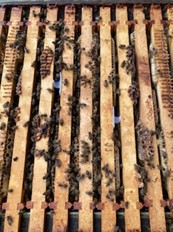 During our rounds this month, as always with beekeeping, not everything always goes to plan and the hives aren’t always in tip top condition, as we would like. We noticed in this colony here that there was a small amount of sacbrood. This virus can be exacerbated by an overload of varroa so we have our fingers crossed that the Apivar will help with that and that next year the sacbrood will be kept to a minimum. You can see here a couple of pointed heads, the classic ‘Chinese slipper’ shape within the brood there. It is not normally a big problem, but it is something we like to keep an eye on.
During our rounds this month, as always with beekeeping, not everything always goes to plan and the hives aren’t always in tip top condition, as we would like. We noticed in this colony here that there was a small amount of sacbrood. This virus can be exacerbated by an overload of varroa so we have our fingers crossed that the Apivar will help with that and that next year the sacbrood will be kept to a minimum. You can see here a couple of pointed heads, the classic ‘Chinese slipper’ shape within the brood there. It is not normally a big problem, but it is something we like to keep an eye on.
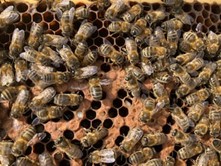 In addition, we had an instance of brace comb gone wild! This hive had an eke that must have got stuck after the last feed (you can see it is stuck in the roof here) and so the roof will have had extra space in there that we did not see. As a result, the bees decided to come up out through the top of the crownboard and build their own comb in the roof. This is rather frustrating as it is a silly mistake and just another job we have to sort out but it is amazing to see what the bees can do when left to their own devices!
In addition, we had an instance of brace comb gone wild! This hive had an eke that must have got stuck after the last feed (you can see it is stuck in the roof here) and so the roof will have had extra space in there that we did not see. As a result, the bees decided to come up out through the top of the crownboard and build their own comb in the roof. This is rather frustrating as it is a silly mistake and just another job we have to sort out but it is amazing to see what the bees can do when left to their own devices!
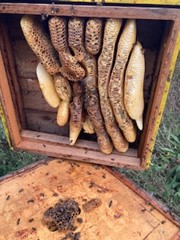 Finally, we always like to see the other wildlife that the lakes apiary in particular has to offer and this month, as we were having a much-needed drink sat in the car, my beekeeping friend shouted, ‘Look at that!’ and something scurried across the grass so fast towards the hedge that I didn’t even see what it was.
Finally, we always like to see the other wildlife that the lakes apiary in particular has to offer and this month, as we were having a much-needed drink sat in the car, my beekeeping friend shouted, ‘Look at that!’ and something scurried across the grass so fast towards the hedge that I didn’t even see what it was. 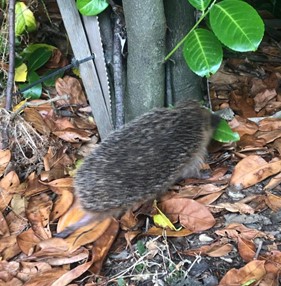 We scrambled out the car to inspect and we came across the world’s fastest hedgehog! You can see how quickly it was moving by its blurry little leg!
We scrambled out the car to inspect and we came across the world’s fastest hedgehog! You can see how quickly it was moving by its blurry little leg!
The bees are starting to wind down, however we will still have plenty of jobs to do next month such as putting mouseguards on, continuing to tidy up the apiary and making sure the bees have plenty of food.
Book review
‘Honeybee Anatomy Brought to Life’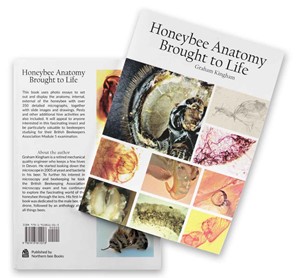
By Graham Kingham
Published 2021 by Northern Bee Books, ISBN 9781914934124.
Buy: https://www.northernbeebooks.co.uk/products/honeybee-anatomy-brought-to-life-kingham/
I expect that this book will be of immense value to anyone who is taking Microscopy exams, or any other senior exams, in Beekeeping. It is illustrated in the most lavish way with superb photos of every aspect of honeybee anatomy, taken through the microscope. That in itself will surely make it tremendously helpful for your studies - it is like having a personal laboratory ready to hand. The book also includes many more familiar images taken from Dade, and I felt that this was also very helpful. Sometimes the black and white diagrams are quite hard to imagine as actual physical parts of the bee’s anatomy, and the juxtaposition of the two (the photos and the diagrams) is extremely useful.
The text is also far more engaging than is usual in books on anatomy. Kingham clearly loves all kinds of analytical thought because he gives the Latin or Greek origins of the technical names for all the parts of the bee. For instance, he explains: ’Larva: the word ‘larva’ means ‘disguise’ or ‘ghost’; and in the main text, he often clarifies the meaning of the terms as well, such as ‘hormones - Greek for ‘setting in motion’ - which are secreted in the body…’ The text is very accessible, and even though some chapters are highly technical, Kingham takes pains to clarify exactly what is meant: for instance, ‘Morphometry is the precise study of anatomical characters by measurement, whereas morphology is the study of form and structure.’ In the Introduction he says that the book is intended ‘to be used alongside the great textbooks… such as Dade, Goodman, Nelson, Snodgrass and Snell.’ I feel that this aim of writing in such a way as to help people study has been more than fulfilled.
I confess that I have no particular interest either in bee anatomy or in microscopes, but I was quite won over by this book. I’m used to consulting passages from Winston’s ‘Biology of the Honey Bee’ when I really want to understand something, but the idea of dissecting a bee has never appealed to me. However, I could not skip any sections of Kingham’s Anatomy, it was so interesting to read. I learned some unexpected things, as well: how bees hear would be one such. I thought they didn’t ‘hear’ but I stand corrected: their ‘organs of Johnson & Jacobson’ which are common to most insects, serve to ‘hear’ as well as to ‘smell’. Thanks to this explanation, queen piping now makes sense. The descriptions of the fat body and the glands, for example, are written with a direct simplicity which makes the importance of these to bee health very clear. He moves easily from the confines of bee anatomy to relate it to more familiar things, like our own anatomy, comparing the bee’s fat body with our own liver. I was also delighted to collect a stray ‘fact’ in passing: that silkworms are the only domesticated insect. This snippet of knowledge comes as Kingham explains how the larval coccoon is spun. In short, he goes out of his way to make a rather dry, and even uninviting subject interesting and memorable.
The last few pages of this book leave the main topic entirely, and deal briefly with ‘uninvited guests’ of bees - mites, wax moths and wasps. Even these ‘enemies’ are given due attention and illustrated from the microscope by wonderful photographs. A good glossary follows, which would be of great use if you were sitting an exam shortly. Finally there are also helpful notes about microscopes. This was the only section which I couldn’t follow - mea culpa!
Briefly, I have no hesitation in recommending this book for anyone studying for senior beekeeping exams, especially in Microscopy of course. But it is also of sufficient interest to engage a more general reader in these somewhat arcane aspects of keeping bees. And the photographs are quite remarkable in their own right. I feel that Graham Kingham has given us a genuinely interesting book on a dry, not to say uninviting, aspect of the Craft.
- By Mary Montaut
Bees for development
National Honey Show 2021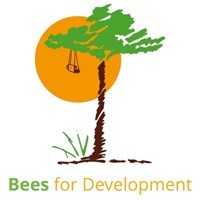
We are looking forward to the National Honey Show at Sandown Park later this month, and hope to meet many of our friends and supporters there. Do come and meet us on our stand, where we will share news of our work, you can pick up tamper proof seals and honey labels, and find a range of perfect gifts for Christmas.
Don't miss our famous and fun Bee Quiz with Bill Turnbull at 6pm on Friday evening (22 Oct) of the Honey Show, wine and supper included. See if you can beat your beekeeping peers at some not-so-seriously challenging bee-related questions! Numbers are limited so book your tickets here.
Christmas is coming, and gift items are available by mail order from our Bees for Development store. Choose from our beautiful range of bee gifts including jewellery and ceramics, bee-themed hampers, delivered to your door.
Here in UK, we are running our Courses in skep making, sustainable livelihoods, and other topics, and we can provide vouchers for gifts. Visit our web shop for details or call us 01600 714848.
Fortnum & Mason Unique Honey Hamper
Fortnum’s are launching their 2021 harvest of London roof-top honeys with a hamper of fantastic prizes worth over £500 in their Honey Hamper Prize Draw - all raising funds for our work. Read more and enter here.
Date for your diary - The Big Give Christmas Challenge begins on Tuesday 30 November for one week, when all donations to Bees for Development will be doubled.
National Honey Show
Deadlines for this year’s live show are right upon us!
- All class entries must reach our entries secretary by Monday 4th October. Do send your entries in good time to avoid disappointment – and us missing out on admiring yours, and your bees’ year’s work. Regrettably we can accept no late entries for 2021.
- Day ticket admission, live streaming (included for National Honey Show members) opened 1st September. Booking closes 11th October to allow tickets to be posted. Members and day visitors can attend our workshops, but numbers are limited and booking essential. Workshop booking opened as usual 1st September.
- Workshop booking opened 1st September. Woprksdhops are open to members and day visitors. There are still spaces in some workshops. Visit https://www.honeyshow.co.uk/workshop-booking.php
- Unique circumstances for this year’s show. To keep everyone safe:
We, the committee are
- Working to reduce crowding and queueing in the foyer, asking visitors to book their admission tickets in advance
- Working to increase spacing in lectures and workshops
- We will be wearing face masks in public areas
- Ensuring the venue is well ventilated (wrap up warm, windows will be open in lecture rooms)
- Providing adequate space for social distancing
- Reducing the need for handling cash
You, visitors can help by
- Using the hand sanitisers provided
- Wearing face masks whenever possible and sensible
- Respecting social distancing
- Working with us to enjoy the show!
We have another great show for you and look forward to seeing you there at Sandown Park, 21st to 23rd October 2021.
Upcoming Events
Rand Open Day: 9th October – 8am for thirds and pre-ordered collections & 9am for general sale shopping
National Honey Show: 21st – 23rd October
Black Friday Deals: 26th November
